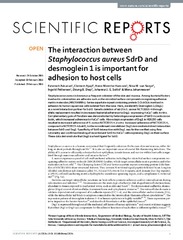| dc.contributor.author | Askarian, Fatemeh | |
| dc.contributor.author | Ajayi, Clement | |
| dc.contributor.author | Hanssen, Anne-Merethe | |
| dc.contributor.author | Van Sorge, Nina M. | |
| dc.contributor.author | Pettersen, Ingvild | |
| dc.contributor.author | Diep, Dzung Bao | |
| dc.contributor.author | Sollid, Johanna U. Ericson | |
| dc.contributor.author | Johannessen, Mona | |
| dc.date.accessioned | 2016-08-19T11:59:24Z | |
| dc.date.available | 2016-08-19T11:59:24Z | |
| dc.date.issued | 2016-02-29 | |
| dc.description.abstract | <i>Staphylococcus aureus</i> is known as a frequent colonizer of the skin and mucosa. Among bacterial factors
involved in colonization are adhesins such as the microbial surface components recognizing adhesive
matrix molecules (MSCRAMMs). Serine aspartate repeat containing protein D (SdrD) is involved in
adhesion to human squamous cells isolated from the nose. Here, we identify Desmoglein 1 (Dsg1)
as a novel interaction partner for SdrD. Genetic deletion of
<i>sdrD</i> in <i>S. aureus</i>NCTC8325-4 through
allelic replacement resulted in decreased bacterial adherence to Dsg1- expressing HaCaT cells
<i>in vitro</i>.
Complementary gain-of-function was demonstrated by heterologous expression of SdrD in <i>Lactococcus
lactis</i>, which increased adherence to HaCaT cells. Also ectopic expression of Dsg1 in HEK293 cells
resulted in increased adherence of <i>S. aureus</i>
NCTC8325-4 <i>in vitro</i>. Increased adherence of NCTC8325-4, compared to NCTC8325-4Δ<i>sdrD</i>,
to the recombinant immobilized Dsg1 demonstrated direct interaction between SdrD and Dsg1. Specificity of SdrD interaction with Dsg1 was further verified using flow
cytometry and confirmed binding of recombinant SdrD to HaCaT cells expressing Dsg1 on their surface.
These data demonstrate that Dsg1 is a host ligand for SdrD. | |
| dc.description.sponsorship | This project was funded by The Northern Norway Regional Health Authority/UiT-The Artic University of Norway “miljøstøtte” to JS and NWO-VIDI grant (91713303) to NvS. | en_US |
| dc.description | Source at <a href=http://doi.org/10.1038/srep22134>http://doi.org/10.1038/srep22134</a> | en_US |
| dc.identifier.citation | Askarian, F., Ajayi, C., Hanssen, A-M., van Sorge, N.M., Pettersen, I., Diep, D.B. ... Johannessen, M. (2016). The interaction beween <i>Staphylococcus aureus</i> SdrD and desmoglein 1 is important for adhesion to host cells. <i>Scientific Reports, 6</i>, 22134. http://doi.org/10.1038/srep22134 | en_US |
| dc.identifier.cristinID | FRIDAID 1331755 | |
| dc.identifier.issn | 2045-2322 | |
| dc.identifier.uri | https://hdl.handle.net/10037/9518 | |
| dc.identifier.urn | URN:NBN:no-uit_munin_9078 | |
| dc.language.iso | eng | en_US |
| dc.publisher | Nature Publishing Group | en_US |
| dc.relation.ispartof | Ajayi, C. (2018). Determinants of Staphylococcus aureus Colonization and Infection.
“Exploring the Role of Cell Wall Anchored Proteins in Adhesion and Immune Evasion”. Doctoral thesis. <a href=http://hdl.handle.net/10037/14070>http://hdl.handle.net/10037/14070</a> | |
| dc.rights.accessRights | openAccess | |
| dc.subject | VDP::Medisinske Fag: 700::Basale medisinske, odontologiske og veterinærmedisinske fag: 710::Medisinsk mikrobiologi: 715 | en_US |
| dc.subject | VDP::Medisinske Fag: 700::Basale medisinske, odontologiske og veterinærmedisinske fag: 710::Medisinsk immunologi: 716 | en_US |
| dc.subject | VDP::Medisinske Fag: 700::Basale medisinske, odontologiske og veterinærmedisinske fag: 710::Medisinsk molekylærbiologi: 711 | en_US |
| dc.title | The interaction between Staphylococcus aureus SdrD and desmoglein 1 is important for adhesion to host cells | en_US |
| dc.type | Journal article | en_US |
| dc.type | Tidsskriftartikkel | en_US |
| dc.type | Peer reviewed | en_US |


 English
English norsk
norsk


